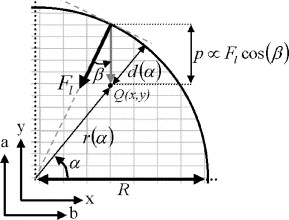Parametric curve representation:
As a point on a parametric curve is described by a single value of the parameter, the parametric form is axis-independent. The curve end points & length are fixed by the parameter range. Frequently it is convenient to normalize the parameter range for the curve segment of interest to 0 ≤ t ≤ 1. Since a parametric curve is axis-independent, it is easily manipulated by utilizing the affine manipulation transformations.
The simplest parametric 'curve' representation is for a straight line. For two position vectors P1 & P2, a parametric representation of the straight line segment among them is
P (t) = P1 + (P2 - P1) t 0 ≤ t ≤1
As P(t) is a position vector, each of the components of P(t) has a parametric representation x(t) and y(t) among P1 and P2, i.e.
x (t) = x1 + (x2 - x1) t 0 < t < 1
y (t) = y1 + (y2 - y1) t
Comparisons of nonparametric & parametric representation of a circle in the first quadrant are illustrated in Figure. The nonparametric representation of the unit circle in the first quadrant specified by
 0 ≤ t ≤ 1
0 ≤ t ≤ 1
is illustrated in Figure (a). Equal incremental in x were utilized to get the points on the arc. Note down that the resulting arc lengths along the curve are unequal. A poor visual representation of circle result. Furthermore, calculation of the square root is computationally expensive.
 0 ≤ t ≤ 1 x = cos θ, y = sin θ 0 ≤ θ ≤2π
0 ≤ t ≤ 1 x = cos θ, y = sin θ 0 ≤ θ ≤2π

(a): Circle Representations for the First Quadrant